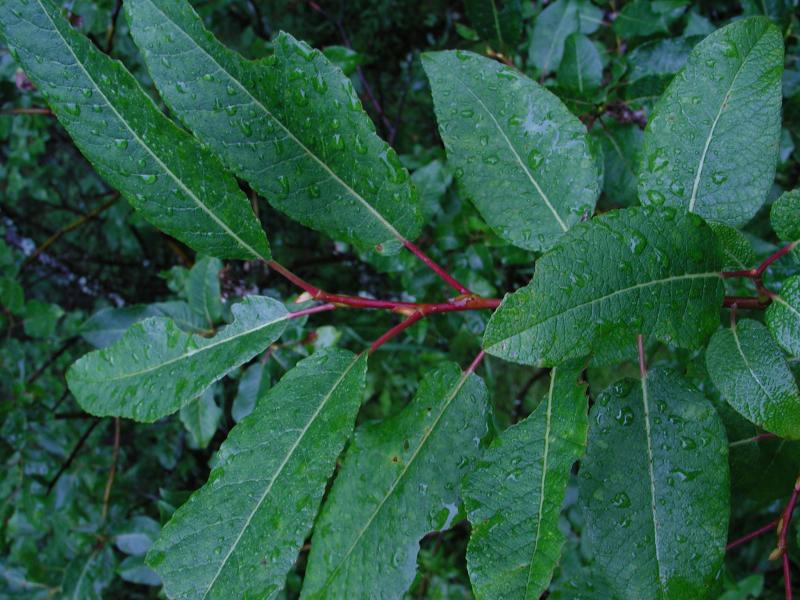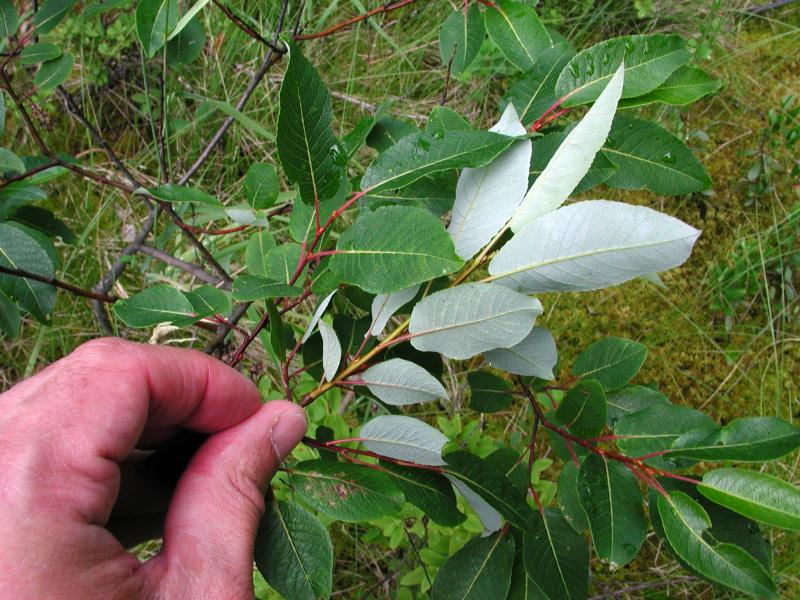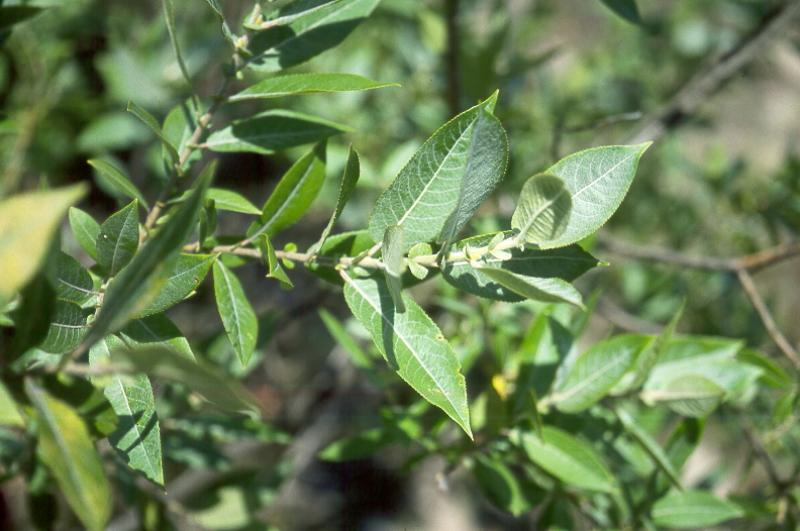Balsam Willow
Salix pyrifolia Anderss.
- Class
- Dicotyledoneae (Dicots)
- Family
- Salicaceae (Willow Family)
- State Protection
- Rare
A plant listed as Rare by New York State. Removal or damage without the consent of the landowner is prohibited.
- Federal Protection
- Not Listed
- State Conservation Status Rank
- S4
Apparently Secure in New York - Uncommon in New York but not rare; usually widespread, but may be rare in some parts of the state; possibly some cause for long-term concern due to declines or other factors.
- Global Conservation Status Rank
- G5
Secure globally - Common in the world; widespread and abundant (but may be rare in some parts of its range).
Summary
Did you know?
Salix pyrifolia is called balsam willow because its leaves and twigs have a resin which causes dried specimens to smell like balsam fir. Willow bark was long used as relief for pain and fevers -- it contains salicylic acid, the active agent in aspirin.
State Ranking Justification
There are 28 verified occurrences, though most are of small populations, and only 5 occurrences which are ranked good to excellent. There are also 20 historical occurrences which need to be checked. In recent years this species has been found more often in the Adirondacks and St. Lawrence County, and could be removed from the rare plant list if additional populations are discovered.
Short-term Trends
New populations of Balsam Willow have been discovered in recent years. The species may be increasing, or, since most populations are small, and may occur alongside other Salix species, it may have been overlooked often until recently.
Long-term Trends
Most of the historical records of this species are from Essex and Franklin Counties, and have not been surveyed in recent years, while most new records are from St. Lawrence County. Surveys of the historically known locations are needed to ascertain the long-term trend of this species in New York.
Conservation and Management
Threats
Changes to the hydrology of wetlands could threaten individual populations, though Balsam Willow may also be able to colonize wetlands following disturbance.
Habitat
Habitat
In New York Salix pyrifolia has been found in a wide variety of northern wetland habitats, including large patterned peatlands, bogs, shrub swamps, headwater seeps in rocky upland forests, balsam flats, and openings in subalpine spruce-fir forests. It will also colonize wet openings created by power line right-of-ways or beaver activity (New York Natural Heritage Program 2008). Low thickets and borders of woods (Fernald 1970). Moist, wet or swampy ground (Gleason & Cronquist 1991). In wet places, particularly black spruce-tamarack bogs, alder swamps, and sandy shores of ponds, creeks, and lakes; also in damp sandy ditches (Soper 1982).
Associated Ecological Communities
- Balsam flats
(guide)
A conifer forest that occurs on moist, well-drained soils of low flats adjoining swamps, gentle low ridges, and knolls within swamps. The dominant tree is balsam fir, which occurs either in pure stands or in mixed stands with red spruce or black spruce.
- Black spruce-tamarack bog
(guide)
A conifer forest that occurs on acidic peatlands in cool, poorly drained depressions. The characteristic trees are black spruce and tamarack; in any one stand, either tree may be dominant, or they may be codominant. Canopy cover is quite variable, ranging from open canopy woodlands with as little as 20% cover of evenly spaced canopy trees to closed canopy forests with 80 to 90% cover.
- Dwarf shrub bog*
(guide)
A wetland usually fed by rainwater or mineral-poor groundwater and dominated by short, evergreen shrubs and peat mosses. The surface of the peatland is usually hummocky, with shrubs more common on the hummocks and peat moss throughout. The water in the bog is usually nutrient-poor and acidic.
- Highbush blueberry bog thicket*
(guide)
A wetland usually fed by rainwater or mineral-poor groundwater and dominated by tall shrubs and peat mosses. The most abundant shrub is usually highbush blueberry. The water in the bog is usually nutrient-poor and acidic.
- Medium fen*
(guide)
A wetland fed by water from springs and seeps. These waters are slightly acidic (pH values generally range from 4.5 to 6.5) and contain some dissolved minerals. Plant remains in these fens do not decompose rapidly and thus the plants in these fens usually grow on older, undecomposed plant parts of woody material, grasses, and mosses.
- Mountain spruce-fir forest
(guide)
A conifer forest that occurs at high elevations in the Catskill and Adirondack mountains, usually at elevations ranging from 3000 to 4000 ft. This forest occurs on upper slopes that are somewhat protected from the prevailing westerly winds, usually at elevations above spruce-northern hardwood forests, and below mountain fir forests. The dominant trees are red spruce and balsam fir.
- Patterned peatland
(guide)
A large peatland whose surface forms a gentle slope with a mosaic of high and low areas (relative to water levels). These high and low areas occur as narrow or broad bands of vegetation and pools that extend perpendicular to the direction of water flow across the slope of the peatland. Peat moss (Sphagnum) is the most abundant plant.
- Perched bog*
(guide)
A wetland that occurs in shallow depressions in rock outcrops where the water table is locally higher than expected (perched) because of an impervious soil or rock layer. The most abundant plants are peat mosses (Sphagnum) and ericaceous shrubs. The water is usually very acidic and has low amounts of dissolved minerals.
- Shrub swamp
(guide)
An inland wetland dominated by tall shrubs that occurs along the shore of a lake or river, in a wet depression or valley not associated with lakes, or as a transition zone between a marsh, fen, or bog and a swamp or upland community. Shrub swamps are very common and quite variable.
* probable association but not confirmed.
Associated Species
- Achillea millefolium (yarrow)
- Agrostis capillaris (Rhode Island bent)
- Alnus incana
- Carex pallescens (pale sedge)
- Carex stricta (tussock sedge)
- Chamaedaphne calyculata (leatherleaf)
- Cladina sp.
- Eriophorum vaginatum (tussock cotton-grass)
- Euthamia caroliniana (slender flat-topped-goldenrod)
- Festuca rubra
- Fragaria virginiana
- Hieracium sp.
- Kalmia angustifolia
- Larix laricina (tamarack)
- Photinia melanocarpa
- Picea mariana (black spruce)
- Populus deltoides
- Prunus virginiana
- Rhododendron groenlandicum (Labrador-tea)
- Salix eriocephala (heart-leaved willow, Missouri willow)
- Scirpus atrovirens (dark-green bulrush)
- Solidago rugosa
- Sphagnum sp
- Spiraea alba
- Vaccinium angustifolium (common lowbush blueberry)
- Vaccinium pallidum (hillside blueberry)
- Viburnum nudum var. cassinoides (northern wild-raisin)
- Vicia cracca (tufted vetch)
Range
New York State Distribution
Salix pyrifolia is known from northern New York, chiefly from the Adirondacks and the St. Lawrence Valley.
Global Distribution
Salix pyrifolia is found in the boreal forest zone of Canada, and reaches its southern limit in the northern forests of Minnesota, Wisconsin, Michigan, New York, and New England.
Identification Comments
General Description
Balsam Willow is a tall ( up to 5 m) shrub or small tree of northern wetlands. Like all willows, the buds have only a single scale, the plants are dioecious (either male or female, but not both), and the flowers are borne in tight clusters called catkins. The twigs are glabrous, at first yellowish but becoming bright red when in sunlight. The leaves lack stipules (or have only minute and quickly deciduous ones 1-2 mm long), and are up to 10 cm long, with serrate to crenate margins, and are shiny above but glaucous with prominent veination underneath. The catkins emerge with or after the leaves, and have persistent dark brown scales 2 to 2.5 mm long. The male flowers are on peduncles 2 to 8 mm long, and have 2 stamens. Female flowers are on leafy peduncles 1 to 3 cm long.
Best Life Stage for Proper Identification
Salix pyrifolia is best identified when mature fruit is present, though identification from mature leaves vegetative is also possible.
Similar Species
The leaves of Salix myricoides and S. eriocephala have pubescent petioles and persistent stipules with pale hairs and asymmetrical leaf bases. No other willow has leaves and buds that have a balsam-like fragrance.
Best Time to See
Salix pyrifolia flowers in early June, and fruits persist into July. The leaves remain to the first frost.
- Vegetative
- Flowering
- Fruiting
The time of year you would expect to find Balsam Willow vegetative, flowering, and fruiting in New York.
Balsam Willow Images
Images of Similar Species
Taxonomy
Balsam Willow
Salix pyrifolia Anderss.
- Kingdom Plantae
- Phylum Anthophyta
- Class Dicotyledoneae
(Dicots)
- Order Salicales
- Family Salicaceae (Willow Family)
- Order Salicales
- Class Dicotyledoneae
(Dicots)
- Phylum Anthophyta
Synonyms
- Salix balsamifera Barratt ex Andersson
- Salix cordata var. balsamifera (Willd.) Torrey
Additional Resources
References
Argus, G.W. 2005. Guide to the Identification of the Genus Salix (Willow) in New England and New York. Unpublished manuscript.
Fernald, M.L. 1950. Gray's manual of botany. 8th edition. D. Van Nostrand, New York. 1632 pp.
Gleason, Henry A. 1952. The New Britton and Brown Illustrated Flora of the Northeastern United States and Canada.
Gleason, Henry A. and A. Cronquist. 1991. Manual of Vascular Plants of Northeastern United States and Adjacent Canada. The New York Botanical Garden, Bronx, New York. 910 pp.
Little, E.L., Jr. 1979. Checklist of United States trees (native and naturalized). Agriculture Handbook No. 541. U.S. Forest Service, Washington, D.C. 375 pp.
Mitchell, Richard S. and Gordon C. Tucker. 1997. Revised Checklist of New York State Plants. Contributions to a Flora of New York State. Checklist IV. Bulletin No. 490. New York State Museum. Albany, NY. 400 pp.
New York Natural Heritage Program. 2024. New York Natural Heritage Program Databases. Albany, NY.
Reschke, Carol. 1990. Ecological communities of New York State. New York Natural Heritage Program, New York State Department of Environmental Conservation. Latham, NY. 96 pp. plus xi.
Soper, James H. and Margaret L. Heimburger. 1982. Shrubs of Ontario. The Royal Ontario Museum, Toronto, Canada, 495P.
Links
About This Guide
Information for this guide was last updated on: January 22, 2009
Please cite this page as:
New York Natural Heritage Program. 2024.
Online Conservation Guide for
Salix pyrifolia.
Available from: https://guides.nynhp.org/balsam-willow/.
Accessed July 26, 2024.



